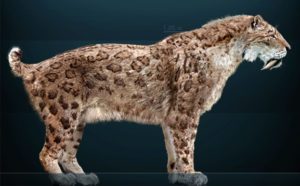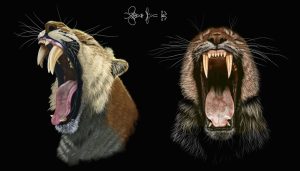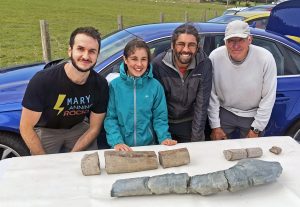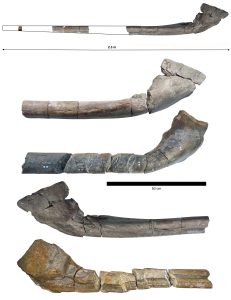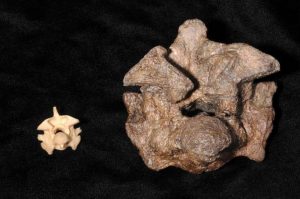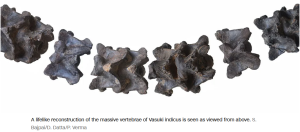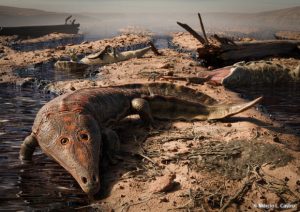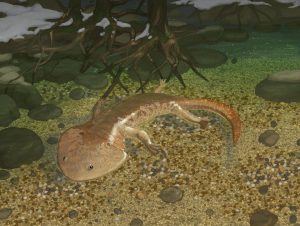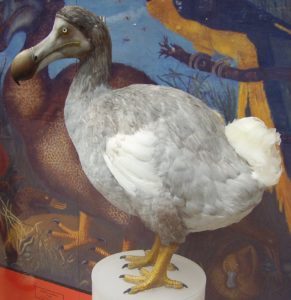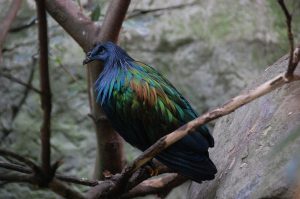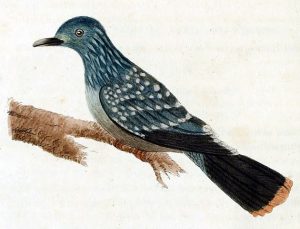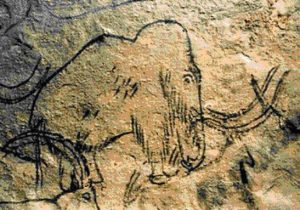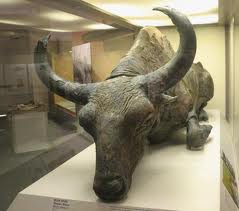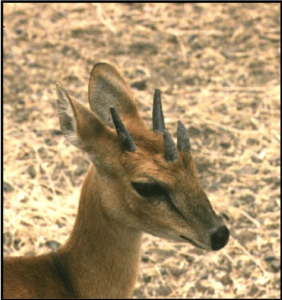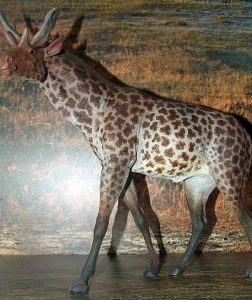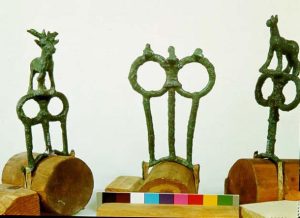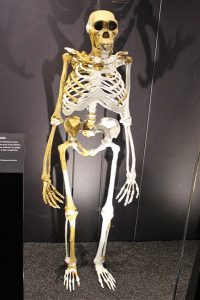Podcast: Play in new window | Download (Duration: 15:30 — 18.2MB)
This week we need to thanks a bunch of listeners for their suggestions: Bowie, Eilee, Pranav, and Yuzu!
Further reading:
Elaborate Komodo dragon armor defends against other dragons
Giant killer lizard fossil shines new light on early Australians
A New Origin for Dragon Folklore?
The Komodo dragon:
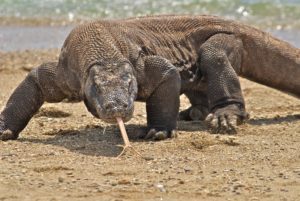
The beautiful tree goanna:
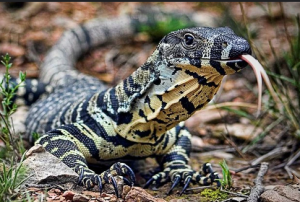
The perentie:
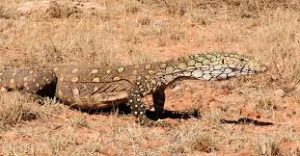
Fossilized scale tree bark looks like reptile scales:
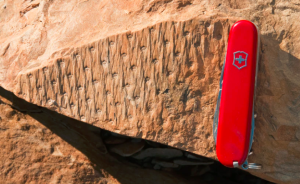
Show transcript:
Welcome to Strange Animals Podcast. I’m your host, Kate Shaw.
This week we’re going to revisit a popular topic we talked about back in episode 53. That episode was about dragons, including the Komodo dragon. Since then, Bowie has requested to learn more about the Komodo dragon and Eilee and Pranav both suggested an updated dragon episode. We also have a related suggestion from Yuzu, who wants to learn more about goannas in general.
We’ll start with the Komodo dragon, which gets its name because it’s a huge and terrifying monitor lizard. It can grow over 10 feet long, or 3 meters, which means it’s the biggest lizard alive today. It has serrated teeth that can be an inch long, or 2.5 cm, and its skin is covered with bony osteoderms that make it spiky and act as armor. Since the Komodo dragon is the apex predator in its habitat, it only needs armor to protect it from other Komodo dragons.
Fortunately for people who like to hike and have picnics in nature, the Komodo dragon only lives on four small islands in Indonesia in southeast Asia, including the island of Komodo. Young Komodo dragons have no armor and spend most of the time in trees, where they eat insects and other small animals. As the dragon gets older and heavier, it spends more and more time on the ground. Its armor develops at that point and is especially strong on the head. The only patches on the head that don’t have osteoderms are around the eyes and nostrils, the edges of the mouth, and over the pineal eye. That’s an organ on the top of the head that can sense light. Yes, it’s technically a third eye!
The Komodo dragon is an ambush predator. When an animal happens by, the dragon jumps at it and gives it a big bite from its serrated teeth. Not only are its teeth huge and dangerous, its saliva contains venom. It’s very good at killing even a large animal like a wild pig quickly, but if the animal gets away it often dies from venom, infection, and blood loss.
Like a lot of reptiles, the Komodo dragon can swallow food that’s a lot bigger than its mouth. The bones of its jaws are what’s called loosely articulated, meaning the joints can flex to allow the dragon to swallow a goat whole, for instance. Its stomach can also expand to hold a really big meal all at once. After a dragon has swallowed as much as it can hold, it lies around in the sun to digest its food. After its food is digested, which can take days, it horks up a big wad of whatever it can’t digest. This includes hair or feathers, horns, hooves, teeth, and so on, all glued together with mucus.
A Komodo dragon eats anything it can catch, and the bigger the dragon is, the bigger the animals it can catch. One thing Komodo dragons are just fine with eating are other Komodo dragons.
As we mentioned a few minutes ago, the Komodo dragon is a type of monitor lizard, and there are lots of monitor lizards that live throughout much of the warmest parts of the earth, including Australia. Yuzu suggested we talk about the goanna, which is the term for monitor lizards in the genus Varanus, although it’s also a term sometimes used for all monitor lizards. Goannas are more closely related to snakes than to other types of lizard.
Like the Komodo dragon, the goanna will eat pretty much any animal it can catch, and will also scavenge already dead animals. Smaller goannas mostly eat insects, especially the tiny goanna often called the short-tailed pygmy monitor or just the pygmy monitor. Its tail is actually pretty long for its size. It only grows about 8 inches long at most, or 20 cm, and babies are less than the length of your pinkie finger. It spends most of its time underground in a burrow, but comes out to hunt for grasshoppers and other insects, spiders, scorpions, and sometimes frogs and small snakes. Many species of goanna spend the hottest part of the day in a burrow, and some species will hibernate in winter.
Most goannas spend all their time on the ground unless they’re actually underground, but some live in trees. The tree goanna, also called the lace monitor or just lacy, can grow up to seven feet long, or over two meters, but is lightly built to climb around on tree branches looking for food. The tree goanna eats a whole lot of bird eggs, along with whatever animals it can catch in trees or on the ground. It eats a lot of carrion and will even get into trash cans if it smells food. When the female is ready to lay her eggs, she digs a hole in the side of a termite nest and lays them in the nest. The termites repair the hole, which hides the eggs, and when the babies hatch, they have lots of termites to eat. The mother goanna keeps watch on the termite nest and once her eggs hatch, she’ll dig into it again to let her babies out.
Genetic testing has discovered that the tree goanna is the closest living relative to the Komodo dragon, but another relative is the biggest goanna alive today in Australia. It’s called the perentie and it can definitely grow up to 8 and a half feet long, or 2.5 meters, and possibly close to 10 feet long, or 3 meters. That’s almost the length of the Komodo dragon.
Long as it is, the perentie isn’t very heavy for its size. It has big claws that allow it to dig quickly, so that if it feels threatened it can dig a burrow and hide in it in only a few minutes. It can also climb trees and is a fast runner. Sometimes it will rear up on its hind legs, propping itself up with its tail, to get a good look around. It’s covered with a maze-like pattern of spots and speckles, and it has a very long neck and a very long tail. Like most monitor lizards, its head is flattened so that it looks a little like a snake’s head. Also like other monitor lizards, it has a long forked tongue that it flicks in and out like a snake to detect the chemical signature of other animals nearby, sort of like smelling but with the tongue.
Also like other monitor lizards, the perentie has a venomous bite. Its venom isn’t all that strong, but you still wouldn’t want to get nipped by one. A big perentie will kill and eat just about anything it can catch, including wombats and small kangaroos. It’s not dangerous to humans, though, and in fact very few people in Australia have ever seen a perentie in the wild. It’s shy and lives in remote areas, mostly in the interior of the country over to the western coast.
There used to be a goanna in Australia that was even bigger than the perentie, but it went extinct around 50,000 years ago. We talked about it briefly in episode 325, but Pranav suggested we learn more about it. It’s called megalania and not only was it bigger than the perentie, it made the Komodo dragon look like a little baby lizard. Megalania may have grown as much as 23 feet long, or 7 meters, although most scientists these days think it wasn’t quite that big. The latest estimates are still pretty big, possibly 18 feet long, or 5.5 meters. It was also heavily built, more like the Komodo dragon than the perentie, so it may have weighed as much as a polar bear. That’s about 1200 pounds, or around 550 kg, but I thought the polar bear comparison was funny. We don’t know for sure how big megalania was because we don’t have a complete skeleton.
Megalania has been classified with the living goannas in the genus Varanus, so it was probably related to the Komodo dragon, although we don’t know exactly how closely. It was probably venomous, and we know its teeth were serrated like the Komodo dragon’s. It lived throughout much of eastern Australia and may have been even more widespread, we just don’t know because we don’t have very many fossils.
Megalania lived alongside another giant monitor lizard in what is now Queensland, the Komodo dragon. That’s right, the Komodo dragon once lived in Australia, although it went extinct there around 300,000 years ago. Megalania went extinct around the time that humans first arrived in Australia, so it’s very possible that the ancestors of today’s Aboriginal Australians encountered it. In 2015, a study was published detailing the discovery of a large goanna osteoderm from a cave system in Queensland. The osteoderm has been dated to about 50,000 years ago and probably belonged to megalania, and some scientists think humans may have been a factor in its extinction, along with climate change.
There are supposedly stories passed down for thousands of years among the Aboriginal Australian peoples that suggest meetings with megalania. I tried hard to find accounts of any of these stories to share, but the sources were always questionable. I did learn that European accounts of the Dreamtime, especially older ones, are inaccurate at best. European colonizers didn’t fully understand the Aboriginal cultures and in many cases weren’t interested in understanding them. They just wanted to collect stories that they would then change to fit the European worldview. This trend continues to the present day, with non-Aboriginal writers changing, misinterpreting, or even straight up inventing Dreamtime stories to fit their own interests. Sometimes that interest is cryptozoology. From what I was able to discover, there really is one aspect of the Dreaming that does apparently include a giant goanna, but that the traditions involved are especially sacred and not meant for outsiders to learn. So it’s none of our business.
As we discussed in episode 53, European stories about dragons were probably inspired by snakes, since early dragons were described as snake-like. Dragon stories in other parts of the world were probably inspired by various local reptiles such as crocodiles. Fossilized bones also played a part, since in the olden days no one knew what dinosaurs were. All anyone knew was that sometimes they found gigantic bones that seemed to be made of stone, and people made up stories to explain them.
Stories about giant reptiles are common throughout much of the world, and in 2020 a study was published suggesting that one of the reasons wasn’t an animal at all. It was a plant, specifically a 300 million year old plant called Lepidodendron, also called the scale tree.
The scale tree wasn’t actually a tree, but it was a really big plant that could grow 160 feet tall, or 50 meters. It’s been extinct for a long time, but it does have living relations called quillworts that kind of look like weird grass.
The scale tree gets its name from the diamond-shaped pattern on its trunk, which looks for all the world like reptile scales. These were just places where leaves once grew, but as the plant got taller, it shed its lower leaves as new ones grew from the top. Different species of the plant had different scale patterns. The study suggests that fossilized pieces of scale tree trunks inspired stories about giant reptiles. Since the plants grew throughout the supercontinent Pangaea and often ended up fossilized in coal beds, their fossils have been found in many different parts of the world.
Let’s finish with a dragon story from England, specifically the village of Sockburn in County Durham. It’s referred to as the Sockburn Worm, since “worm” used to mean any creature that was snakey or worm-shaped in appearance. It’s closely related to the story of the Lambton Worm that we talked about in episode 53.
Once upon a time in the olden days, maybe around 750 years ago, maybe longer ago, Sockburn and the farmland around it were terrorized by a dragon. The dragon had a poisonous breath and would eat anyone it came across, and killed and ate all the livestock it could find. No one could kill it.
Sir John Conyers was a knight who lived in the area and he decided he had to do something. He got dressed in his armor and went to the local church to pray, and said he would give up his only son’s life if it meant killing the dragon. Then he set out to find the dragon.
He didn’t so much find the dragon as the dragon found him. Instead of getting eaten, Sir John drew his magical sword and battled the dragon until finally he lopped its head off with one massive chop. Sir John survived and so did his son.
Centuries later, in 1855, a writer was inspired by the story and wrote a poem based on it. He eventually included the poem in a book called Alice Through the Looking-Glass, the sequel to Alice in Wonderland. You may know the poem “The Jabberwock,” and now you know the dragon story that inspired it.
You can find Strange Animals Podcast at strangeanimalspodcast.blubrry.net. That’s blueberry without any E’s. If you have questions, comments, or suggestions for future episodes, email us at strangeanimalspodcast@gmail.com. We also have a Patreon at patreon.com/strangeanimalspodcast if you’d like to support us for as little as one dollar a month and get monthly bonus episodes.
Thanks for listening!
